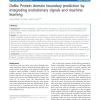19 search results - page 1 / 4 » Evolutionary rates at codon sites may be used to align seque... |
BMCBI
2010
13 years 5 months ago
2010
Background: Sequence alignments form part of many investigations in molecular biology, including the determination of phylogenetic relationships, the prediction of protein structu...
BMCBI
2006
13 years 5 months ago
2006
Background: Several entropy-based methods have been developed for scoring sequence conservation in protein multiple sequence alignments. High scoring amino acid positions may corr...
BMCBI
2011
12 years 12 months ago
2011
Background: Accurate identification of protein domain boundaries is useful for protein structure determination and prediction. However, predicting protein domain boundaries from a...
BMCBI
2008
2008
WSPMaker: a web tool for calculating selection pressure in proteins and domains using window-sliding
13 years 5 months ago
Background: In the study of adaptive evolution, it is important to detect the protein coding sites where natural selection is acting. In general, the ratio of the rate of non-syno...
BMCBI
2005
13 years 4 months ago
2005
Background: Protein sequence alignments have become indispensable for virtually any evolutionary, structural or functional study involving proteins. Modern sequence search and com...

